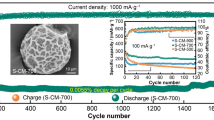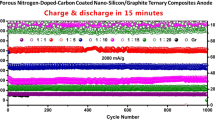Abstract
Within this work, we investigate the structural and electrochemical properties of new composite materials based on disordered carbons embedded into a polymer-derived silicon carbonitride matrix. In particular, we focus on the relationship between the initial characteristic of disordered carbon, that is its microstructure and porosity with the lithium-ions storage properties of the composite. Although there is almost no difference between composites found by means of Raman spectroscopy and X-ray powder diffraction, it is demonstrated that the pore volume of the carbon is of significant importance, i.e., volume of the preceramic polymer must be matched with pore volume of the carbon in order to ensure the optimal electrochemical performance. Thus, it is possible to synthesize a composite containing only 50 % of external carbon, which recovers the capacity comparable to that of pure carbon.




Similar content being viewed by others
References
Winter M, Besenhard JO, Spahr ME, Novák P (1998) Insertion electrode materials for rechargeable lithium batteries. Adv Mater 10(10):725–763
Kaspar J, Graczyk-Zajac M, Riedel R (2013) Lithium insertion into carbon-rich SiOC ceramics: influence of pyrolysis temperature on electrochemical properties. J Power Sources 244:450–455
Haluschka C, Kleebe HJ, Franke R, Riedel R (2000) Silicon carbonitride ceramics derived from polysilazanes part I. Investigation of compositional and structural properties. J Eur Ceram Soc 20(9):1355–1364
Mera G, Riedel R, Poli F, Müller K (2009) Carbon-rich SiCN ceramics derived from phenyl-containing poly(silylcarbodiimides). J Eur Ceram Soc 29(13):2873–2883
Mera G, Navrotsky A, Sen S, Kleebe H-J, Riedel R (2013) Polymer-derived SiCN and SiOC ceramics—structure and energetics at the nanoscale. J Mater Chem A 1(12):3826–3836
Dahn JR, Wilson AM, Xing W, Zank GA inventors, Dow Corning Corp.,assignee (1997) Electrodes for lithium ion batteries using polysilazanes ceramic with lithium, United States Patent US 5631106(A), May 20
Kolb R, Fasel C, Liebau-Kunzmann V, Riedel R (2006) SiCN/C-ceramic composite as anode material for lithium ion batteries. J Eur Ceram Soc 26(16):3903–3908
Su D, Li Y-L, Feng Y, Jin J (2009) Electrochemical properties of polymer-derived SiCN materials as the anode in lithium Ion batteries. J Am Ceram Soc 92(12):2962–2968
Feng Y (2010) Electrochemical properties of heat-treated polymer-derived SiCN anode for lithium ion batteries. Electrochim Acta 55(20):5860–5866
Kaspar J, Mera G, Nowak AP, Graczyk-Zajac M, Riedel R (2010) Electrochemical study of lithium insertion into carbon-rich polymer-derived silicon carbonitride ceramics. Electrochim Acta 56(1):174–182
Graczyk-Zajac M, Mera G, Kaspar J, Riedel R (2010) Electrochemical studies of carbon-rich polymer-derived SiCN ceramics as anode materials for lithium-ion batteries. J Eur Ceram Soc 30(15):3235–3243
Reinold LM, Graczyk-Zajac M, Gao Y, Mera G, Riedel R (2013) Carbon-rich SiCN ceramics as high capacity/high stability anode material for lithium-ion batteries. J Power Sources 236:224–229
Baek S-H, Reinold LM, Graczyk-Zajac M, Riedel R, Hammerath F, Büchner B, Grafe H-J (2014) Lithium dynamics in carbon-rich polymer-derived SiCN ceramics probed by nuclear magnetic resonance. J Power Sources 253:342–348
Fukui H, Hisashi O, Hino T, Kanamura K (2010) A Si-O-C composite anode: high capability and proposed mechanism of lithium storage associated with microstructural characteristics. Appl Mater Interfaces 4:998–1008
Graczyk-Zajac M, Fasel C, Riedel R (2011) Polymer-derived-SiCN ceramic/graphite composite as anode material with enhanced rate capability for lithium ion batteries. J Power Sources 196(15):6412–6418
Reinold LM, Graczyk-Zajac M, Fasel C, Riedel R (2011) Prevention of solid electrolyte interphase damaging on silicon by using polymer derived SiCN ceramics. ECS Trans 35:37–44
Wilamowska M, Graczyk-Zajac M, Riedel R (2013) Composite materials based on polymer-derived SiCN ceramic and disordered hard carbons as anodes for lithium-ion batteries. J Power Sources 24:80–86
Dibandjo P, Graczyk-Zajac M, Riedel R, Pradeep VS, Soraru GD (2012) Lithium insertion into dense and porous carbon-rich polymer-derived SiOC ceramics. J Eur Ceram Soc 32(10):2495–2503
Liu G, Kaspar J, Reinold LM, Graczyk-Zajac M, Riedel R (2013) Electrochemical performance of DVB-modified SiOC and SiCN polymer-derived negative electrodes for lithium-ion batteries. Electrochim Acta 106:101–108
Pradeep VS, Graczyk-Zajac M, Riedel R, Soraru GD (2014) New insights in to the lithium storage mechanism in polymer derived SiOC anode materials. Electrochim Acta 119:78–85
Pradeep VS, Graczyk-Zajac M, Wilamowska M, Riedel R, Soraru GD (2013) Influence of pyrolysis atmosphere on the lithium storage properties of carbon-rich polymer derived SiOC ceramic anodes. Solid State Ionics 262:22–24
Graczyk-Zajac M, Reinold LM, Kaspar J, Sasikumar PVW, Soraru G-D, Riedel R (2015) New insights into understanding irreversible and reversible lithium storage within SiOC and SiCN ceramics. Nanomaterials 5(1):233–245
Ferrari AC, Robertson J (2000) Raman signature of bonding and disordere in carbons. Mater Res Soc Symp Proc 593:299–304
Ferrari AC, Robertson J (2000) Interpretation of Raman spectra of disordered and amorphous carbon. Phys Rev B 61(20):14095–14107
Ferrari AC, Robertson J (2001) Resonant Raman spectroscopy of disordered, amorphous, and diamondlike carbon. Physical Review B 64 (7)
Sadezky A, Muckenhuber H, Grothe H, Niessner R, Pöschl U (2005) Raman microspectroscopy of soot and related carbonaceous materials: spectral analysis and structural information. Carbon 43(8):1731–1742
Pimenta MA, Dresselhaus G, Dresselhaus MS, Cancado LG, Jorio A, Saito R (2006) Studying disorder in graphite-based systems by Raman spectroscopy. Phys Chem Chem Phys 9:1276–1291
Beyssac O, Goffé B, Petitet J-P, Froigneux E, Moreau M, Rouzaud J-N (2003) On the characterization of disordered and heterogeneous carbonaceous materials by Raman spectroscopy. Spectrochim Acta A 59:2267–2276
Sethuraman VA, Hardwick LJ, Srinivasan V, Kostecki R (2010) Surface structural disordering in graphite upon lithium intercalation/deintercalation. J Power Sources 195:3655–3660
Acknowledgments
We gratefully acknowledge the financial support of the German Research Foundation (DFG) SFB 595/A4, SPP1473/J8. We thank Christina Schitco for performing BET measurements. Moreover, we express our gratitude to Mirko Reinold and Jan Kaspar for their help and stimulating discussions.
Author information
Authors and Affiliations
Corresponding author
Rights and permissions
About this article
Cite this article
Graczyk-Zajac, M., Wimmer, M., Neumann, C. et al. Lithium intercalation into SiCN/disordered carbon composite. Part 1: influence of initial carbon porosity on cycling performance/capacity. J Solid State Electrochem 19, 2763–2769 (2015). https://doi.org/10.1007/s10008-015-2814-y
Received:
Revised:
Accepted:
Published:
Issue Date:
DOI: https://doi.org/10.1007/s10008-015-2814-y




